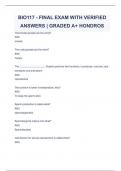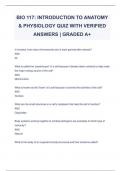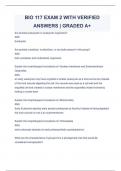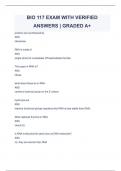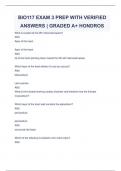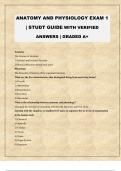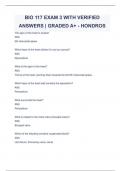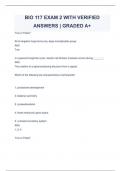West Virginia University
Latest uploads at West Virginia University. Looking for notes at West Virginia University? We have lots of notes, study guides and study notes available for your school.
-
121
- 0
-
10
All courses for West Virginia University
Latest notes & summaries West Virginia University
Anatomy ANS The study of the body structure Gross Anatomy ANS Study of structures that can be seen with the naked eye Microscopic Anatomy ANS deals with structures too small to be seen with the naked eye Physiology ANS The study of bodily functions
In humans, how many chromosomes are in each gamete after meiosis? ANS 23 What is called the "powerhouse" of a cell because it breaks down nutrients to help make the major energy source of the cell? ANS Mitochondria What is known as the "brain" of a cell because it controls the activities of the cell? ANS Nucleus What are the small structures in a cell's cytoplasm that help the cell to function? ANS Organelles
1) There are three layers of neurons in the retina. The axons of which of these neuron layers form the optic nerves? A) cone cells B) ganglion cells C) bipolar cells D) rod cells B) ganglion cells 2) Ordinarily, it is not possible to transplant tissues from one person to another, yet corneas can be transplanted without tissue rejection. This is because the cornea ________. A) does not contain connective tissue B) has no blood supply C) is not a living tissue D) has no nerve supply ...
Are protists prokaryotic or eukaryotic organisms? ANS Eukaryotic Are protists unicellular, multicellular, or are both present in this group? ANS both unicellular and multicellular organisms Explain the morphological innovations of: Nuclear membrane and Endomembrane Organelles ANS an early eukaryote may have engulfed a smaller eukaryote as a food source but instead of the food vacuole digesting the cell, the vacuole was used as a cell wall and the engulfed cell and created a nuclear...
proteins are synthesized by ANS ribosomes RNA is made of ANS single strand of nucleotides (Phosphodiester bonds) The sugar in RNA is? ANS ribose what does ribose do in RNA ANS carries a hydroxyl group on the 2' carbon hydroxyls are ANS reactive functional groups (explains why RNA is less stable than DNA)
What is located at the fifth intercostal space? ANS Apex of the heart Apex of the heart ANS tip of the heart pointing down toward the 5th left intercostal space Which layer of the heart allows it to act as a pump? ANS Myocardium Left ventricle ANS What is the hardest working cardiac chamber and therefore has the thickest myocardium? Which layer of the heart wall contains the epicardium? ANS pericardium.
Anatomy The Science of structure. 1) Internal and External Structure 2) Physical Reaction among body parts Physiology The Structure of function. How organisms function. What are the five characteristics that distinguish living from non living forms? 1) Growth 2) Metabolism 3) Reproduction 4) Excretion 5) Movement What is the relationship between anatomy and physiology? Changing the structure of something will alter the functions, and vice versa. Starting with the simplest, or small...
The apex of the heart is located ANS 5th intercostal space Which layer of the heart allows it to act as a pump? ANS Myocardium What is the apex of the heart? ANS The tip of the heart, pointing down towards the left 5th intercostal space. Which layer of the heart wall contains the epicardium? ANS Pericardium What surrounds the heart? ANS Pericardium
Anterior ANS Before, the region of the body that advances first Posterior ANS Behind Dorsal ANS Back Ventral ANS Belly side Cranial ANS Toward the head
BIO 117 EXAM 2 WITH VERIFIED ANSWERS | GRADED A+ True or False? All of kingdom fungi forms one, large monophyletic group. ANS True In a general fungal life cycle, meiotic cell division (meiosis) occurs during _______. ANS The creation of a spore-producing structure from a zygote. Which of the following are characteristics of arthropods? 1. protostome development 2. bilateral symmetry 3. a pseudocoelom 4. three embryonic germ layers 5. a closed circulatory syste

